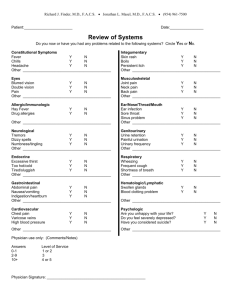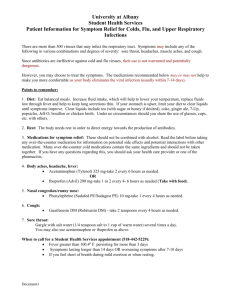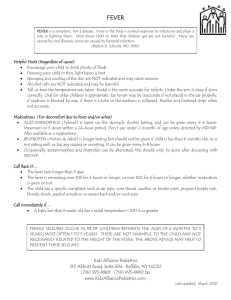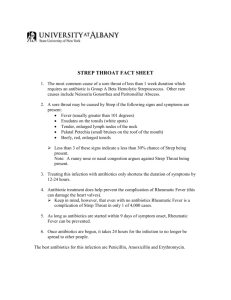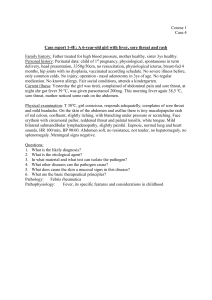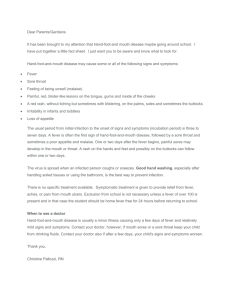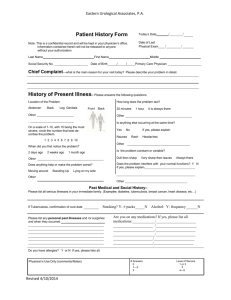Care of patient with fever or URI
advertisement
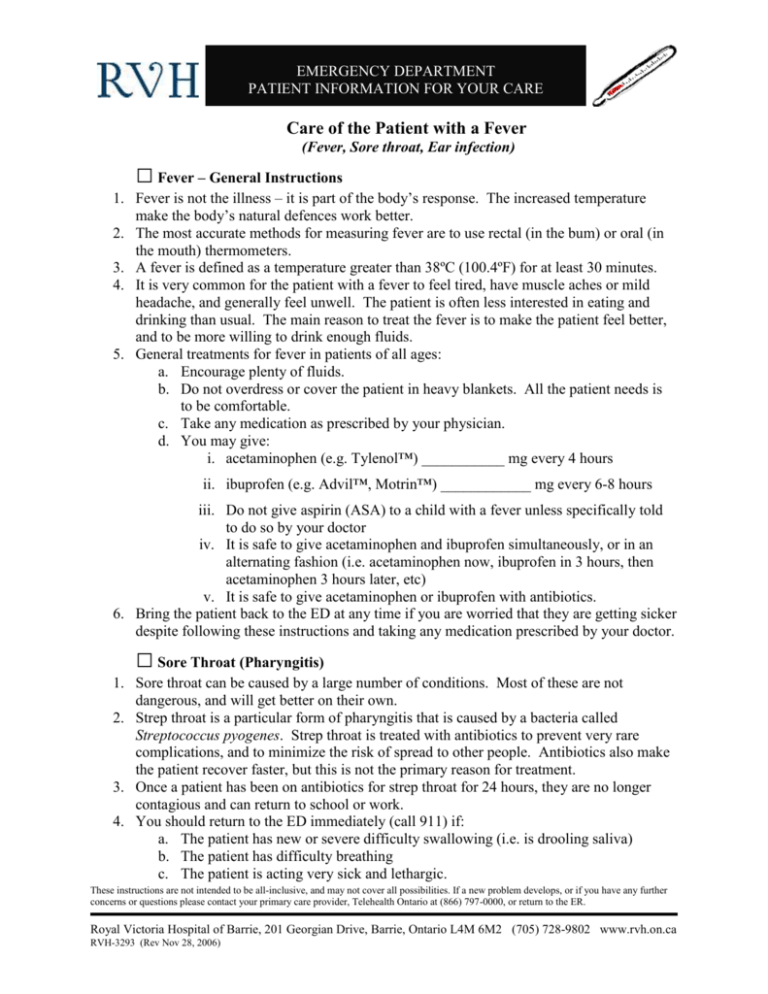
EMERGENCY DEPARTMENT PATIENT INFORMATION FOR YOUR CARE Care of the Patient with a Fever (Fever, Sore throat, Ear infection) □ Fever – General Instructions 1. Fever is not the illness – it is part of the body’s response. The increased temperature make the body’s natural defences work better. 2. The most accurate methods for measuring fever are to use rectal (in the bum) or oral (in the mouth) thermometers. 3. A fever is defined as a temperature greater than 38ºC (100.4ºF) for at least 30 minutes. 4. It is very common for the patient with a fever to feel tired, have muscle aches or mild headache, and generally feel unwell. The patient is often less interested in eating and drinking than usual. The main reason to treat the fever is to make the patient feel better, and to be more willing to drink enough fluids. 5. General treatments for fever in patients of all ages: a. Encourage plenty of fluids. b. Do not overdress or cover the patient in heavy blankets. All the patient needs is to be comfortable. c. Take any medication as prescribed by your physician. d. You may give: i. acetaminophen (e.g. Tylenol™) ___________ mg every 4 hours ii. ibuprofen (e.g. Advil™, Motrin™) ____________ mg every 6-8 hours iii. Do not give aspirin (ASA) to a child with a fever unless specifically told to do so by your doctor iv. It is safe to give acetaminophen and ibuprofen simultaneously, or in an alternating fashion (i.e. acetaminophen now, ibuprofen in 3 hours, then acetaminophen 3 hours later, etc) v. It is safe to give acetaminophen or ibuprofen with antibiotics. 6. Bring the patient back to the ED at any time if you are worried that they are getting sicker despite following these instructions and taking any medication prescribed by your doctor. □ Sore Throat (Pharyngitis) 1. Sore throat can be caused by a large number of conditions. Most of these are not dangerous, and will get better on their own. 2. Strep throat is a particular form of pharyngitis that is caused by a bacteria called Streptococcus pyogenes. Strep throat is treated with antibiotics to prevent very rare complications, and to minimize the risk of spread to other people. Antibiotics also make the patient recover faster, but this is not the primary reason for treatment. 3. Once a patient has been on antibiotics for strep throat for 24 hours, they are no longer contagious and can return to school or work. 4. You should return to the ED immediately (call 911) if: a. The patient has new or severe difficulty swallowing (i.e. is drooling saliva) b. The patient has difficulty breathing c. The patient is acting very sick and lethargic. These instructions are not intended to be all-inclusive, and may not cover all possibilities. If a new problem develops, or if you have any further concerns or questions please contact your primary care provider, Telehealth Ontario at (866) 797-0000, or return to the ER. Royal Victoria Hospital of Barrie, 201 Georgian Drive, Barrie, Ontario L4M 6M2 (705) 728-9802 www.rvh.on.ca RVH-3293 (Rev Nov 28, 2006) EMERGENCY DEPARTMENT PATIENT INFORMATION FOR YOUR CARE □ Sore Throat (Pharyngitis) (continued) 5. Bring the patient to their primary care provider or the ED if: a. They are not improving after 48 hours of antibiotics, or they are getting sicker at any time despite antibiotics b. The patient is having a lot of trouble drinking liquids. 6. General treatment for any patient with a sore throat: a. Drink lots of fluids. Either cold or warm fluids are okay, as long as it is tolerated by the patient. b. You may use medications for fever as described above under “Fever – General Instructions”. The same medications are effective as pain relief as well. □ Ear infection (Otitis media) 1. Ear infections are usually associated with a cold, which blocks the drainage of fluid from the middle ear. This fluid becomes trapped and builds up pressure which causes the pain. The trapped fluid can then become infected with bacteria. 2. Because the fluid and infection are in the middle ear (inside the eardrum), eardrops and other topical treatments like mineral oil do not help. 3. Ear infections are usually treated with antibiotics. These should be taken as directed until they are all gone, even if the patient is feeling better. 4. You may use medications for fever as described above under “Fever – General Instructions”. The same medications are effective as pain relief as well. 5. Bring the patient to their primary care provider or the ED if: a. They are not improving after 48 hours of antibiotics, or they are getting sicker at any time despite antibiotics b. They are vomiting and unable to take their medicine c. The pain is too bad to manage at home. 6. An ear infection is not contagious, but the cold that preceded it is. The patient may return to school/work when the fever has passed and they are feeling better. 7. The patient may swim, bathe, or shower as long as there is no perforation of the eardrum. If you are not sure about this, ask your doctor or nurse. These instructions are not intended to be all-inclusive, and may not cover all possibilities. If a new problem develops, or if you have any further concerns or questions please contact your primary care provider, Telehealth Ontario at (866) 797-0000, or return to the ER. Royal Victoria Hospital of Barrie, 201 Georgian Drive, Barrie, Ontario L4M 6M2 (705) 728-9802 www.rvh.on.ca RVH-3293 (Rev Nov 28, 2006)
